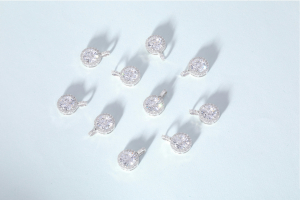USD
/
USD
/
Shipping to:
Currency:
Why Lab-Grown Diamonds Are Gaining Popularity Among Consumers
Lab-grown diamonds have become more than just a trend. They’re revolutionizing the jewelry industry. Once a rare choice, these diamonds have seen a significant surge in popularity, reshaping consumer expectations and transforming the way people shop for fine jewelry. In this article, we’ll dive into why lab-grown diamonds are taking center stage and why more people are choosing them for their sparkle, affordability, and ethical appeal.
What Are Lab-Grown Diamonds?
Before we get into the reasons behind their popularity, it’s essential to understand what lab-grown diamonds are. Lab-grown diamonds are created in a controlled environment using cutting-edge technology that mimics the natural formation process of diamonds in the Earth’s crust. These diamonds have the same physical, chemical, and optical properties as mined diamonds, meaning they’re visually and structurally identical. Lab-created diamonds are often produced using one of two methods: Chemical Vapor Deposition (CVD) or High-Pressure, High-Temperature (HPHT). For a closer look at lab-grown diamonds, you can explore the variety available.
For consumers, the result is a stunning, genuine diamond that’s nearly impossible to distinguish from a mined diamond without specialized equipment. These diamonds sparkle just as brilliantly, yet come with several unique benefits that appeal to today’s buyers.
Cost-Effective Luxury: High Quality at a Lower Price
One of the primary reasons for the rise in lab-grown diamond popularity is their affordability. Lab-grown diamonds typically cost 20-40% less than mined diamonds of comparable quality. The reduced cost doesn’t mean compromising on quality. Lab-grown diamonds have the same brilliance, fire, and durability as their natural counterparts. If you're interested in comparing sizes, browse round lab-grown diamonds or cushion lab-grown diamonds for inspiration.
For many, this price difference means they can afford a larger or higher-quality diamond than they would with a mined diamond. Couples seeking engagement rings, for instance, can often choose a larger carat size within the same budget. This cost-effectiveness has made lab-grown diamonds especially appealing for anyone wanting luxurious jewelry without the high price tag.
Sustainable and Ethical Choice
Sustainability and ethics are two words rarely associated with traditional diamond mining, but they’re central to the appeal of lab-grown diamonds. Unlike mined diamonds, lab-grown diamonds don’t involve destructive mining practices or extensive land degradation. They require fewer resources, and their production doesn’t disturb natural ecosystems, making them a sustainable choice for eco-conscious shoppers. To view eco-friendly options in different shapes, you might want to check out emerald lab-grown diamonds or heart lab-grown diamonds.
Moreover, ethical sourcing has become a critical concern for many consumers. With lab-grown diamonds, there are no questions about conflict zones or unethical labor practices. Buyers can feel good knowing their diamond wasn’t tied to potentially harmful practices, allowing them to align their purchase with their values.
Enhanced Transparency in Sourcing
Transparency has been a significant issue within the diamond industry. For decades, traceability has been difficult to guarantee with mined diamonds, creating uncertainty for consumers who care about the origin of their purchases. Lab-grown diamonds, on the other hand, offer a clear supply chain, ensuring buyers know exactly where their stone came from. If you prefer colored stones, consider fancy colored lab-grown diamonds for a dazzling array of hues.
This enhanced transparency is a breath of fresh air for ethically-minded consumers. By choosing lab-grown diamonds, buyers can trust that their purchase is free from ethical ambiguities and environmental exploitation. In a world where transparency matters more than ever, lab-grown diamonds offer a level of peace of mind that’s hard to find with traditional options.
Customization and Availability of Larger Carat Sizes
One of the exciting advantages of lab-grown diamonds is the availability of larger carat sizes at an accessible price point. With mined diamonds, a larger stone typically comes with a steep increase in price. Lab-grown diamonds make it easier to find a larger, high-quality stone without breaking the bank.
Additionally, lab-grown diamonds offer more customization options. They’re produced with precision, allowing for more variety in shape, color, and size. For couples looking for a unique engagement ring or jewelry lovers seeking standout pieces, the variety and affordability of lab-grown diamonds open up a world of creative possibilities. You can explore different cuts like princess lab-grown diamonds or radiant lab-grown diamonds to find the ideal shape.
Backed by Innovation and Technology
Lab-grown diamonds are born from advanced technology, a factor that appeals to modern, tech-savvy consumers. The processes behind these diamonds—whether CVD or HPHT—are a marvel of scientific innovation, creating diamonds that are both remarkable and ethically produced. This high-tech appeal resonates with buyers who appreciate the innovation behind the stones.
For some, the fact that their diamond was “grown” rather than mined adds an extra layer of fascination. These diamonds represent the future, aligning with the growing consumer preference for tech-driven solutions that address ethical and environmental challenges.
Celebrity Endorsements and Social Media Influence
Lab-grown diamonds have seen a boost in visibility thanks to endorsements from celebrities and influencers. High-profile figures are increasingly choosing lab-grown stones, which has had a ripple effect on consumer preferences. When celebrities endorse lab-grown diamonds, it sends a message to fans and followers that these stones are desirable, luxurious, and worthy of attention.
Social media has played a huge role in spreading the word, with influencers showcasing their lab-grown diamond pieces and sharing the ethical and financial advantages with their audiences. This exposure has helped elevate lab-grown diamonds from a niche choice to a mainstream option, particularly among younger consumers who are active on platforms like Instagram and TikTok.
Concerns and Misconceptions About Lab-Grown Diamonds
Despite their benefits, lab-grown diamonds aren’t free from misconceptions. Some people wonder if they’re as “real” as mined diamonds or question their long-term value. It’s essential to clarify that lab-grown diamonds are genuine diamonds—they’re just created in a lab instead of mined from the earth.
Another concern is resale value. Traditionally, mined diamonds retain more resale value, but this is slowly changing as lab-grown diamonds become more widely accepted. Ultimately, the choice between mined and lab-grown diamonds comes down to individual preferences and values. For most buyers today, the benefits of lab-grown diamonds outweigh concerns about long-term resale value.
FAQs About Lab-Grown Diamonds
Are lab-grown diamonds real diamonds?
Yes. Lab-grown diamonds are real diamonds. They have the same physical, chemical, and optical properties as mined diamonds. The only difference is their origin: they’re created in a lab rather than mined from the earth.
Why are lab-grown diamonds cheaper than mined diamonds?
Lab-grown diamonds are typically more affordable because their production doesn’t involve the same high costs of mining, transport, and environmental impact. This reduced cost makes them a more accessible option for consumers. Check out our asscher lab-grown diamonds for budget-friendly options in unique cuts.
Do lab-grown diamonds retain resale value?
While lab-grown diamonds generally have a lower resale value than mined diamonds, this is changing as they gain popularity. However, most buyers choose lab-grown diamonds for their beauty and ethical benefits rather than for investment purposes.
Are lab-grown diamonds as durable as mined diamonds?
Yes. Lab-grown diamonds are as durable as mined diamonds. Both have a rating of 10 on the Mohs hardness scale, making them suitable for everyday wear, including engagement rings.
How can I tell the difference between a lab-grown diamond and a mined diamond?
It’s challenging to tell the difference between lab-grown and mined diamonds without specialized equipment. Jewelers and gemologists use advanced testing to distinguish between the two, as they look identical to the naked eye.
Are lab-grown diamonds better for the environment?
Lab-grown diamonds generally have a smaller environmental impact than mined diamonds. Their production requires fewer resources and doesn’t involve land degradation, making them a more eco-friendly option.
Why are lab-grown diamonds gaining popularity?
Lab-grown diamonds are popular because they offer affordability, ethical sourcing, and eco-friendly benefits without sacrificing quality. Additionally, they appeal to modern consumers who value transparency and sustainability.







